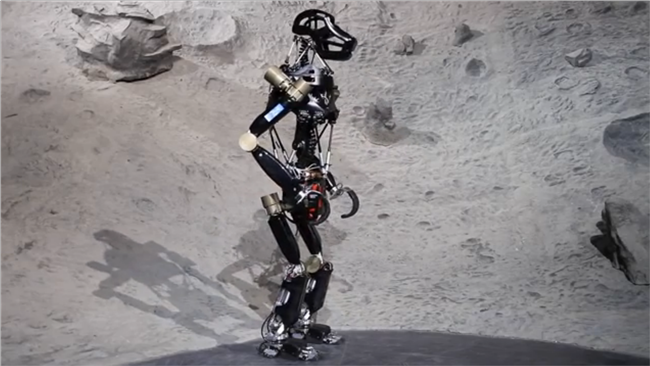IStruct - evolution continues
In just about three months, it took the monkey-like iStruct robot, created at the German Research Center for Artificial Intelligence ( DFKI ), in order to repeat millions of years of evolution and move to upright posture.

Work on robots, which are planned to be used to study lunar craters for the presence of ice in them, began in early March.

The dimensions of the robot are 66 x 43 x 75 cm, weight - 18 kg. In the back of the body are batteries that are a power source. In the area of the "chest" placed control units and communications.
There is no tight connection between the front and back of the case. Instead, they created an analogue of the spine, consisting of articulated elements and providing flexibility and the possibility of displacement.

The robot is equipped with numerous sensors that can determine the pressure, angle, distance, temperature, the presence of obstacles and several motors that allow you to adjust the position of the body depending on the nature of the surface. The accuracy of the movements of the robot is so high that it allows you to maintain balance and balance on surfaces with a changing angle of inclination.
Initially, the robot moved on four limbs. Researchers have suggested that this type of movement will allow robots to move more easily on rough terrain, overcome obstacles and rocky terrain, compared with wheeled or tracked robots, and four fulcrum will increase its stability.
Then the developers thought it would be nice to allow the robot to rise on its hind legs, thereby providing an increase in visibility and the ability to manipulate the forelimbs. Now the robot can not only move on all fours, but also confidently stand on two legs, rotating the spine and moving the forelimbs. This became possible due to the complex structure of the “foot”, on which sensors are placed, which provide multi-point contact of the robot foot with the surface and are associated with the ankle joint drive.
It is not known when iStruct will be able to begin exploring other planets. The immediate prospect for him is an international conference on robotics , which will be held in Tokyo in early November.

Work on robots, which are planned to be used to study lunar craters for the presence of ice in them, began in early March.

The dimensions of the robot are 66 x 43 x 75 cm, weight - 18 kg. In the back of the body are batteries that are a power source. In the area of the "chest" placed control units and communications.
There is no tight connection between the front and back of the case. Instead, they created an analogue of the spine, consisting of articulated elements and providing flexibility and the possibility of displacement.

The robot is equipped with numerous sensors that can determine the pressure, angle, distance, temperature, the presence of obstacles and several motors that allow you to adjust the position of the body depending on the nature of the surface. The accuracy of the movements of the robot is so high that it allows you to maintain balance and balance on surfaces with a changing angle of inclination.
Initially, the robot moved on four limbs. Researchers have suggested that this type of movement will allow robots to move more easily on rough terrain, overcome obstacles and rocky terrain, compared with wheeled or tracked robots, and four fulcrum will increase its stability.
Then the developers thought it would be nice to allow the robot to rise on its hind legs, thereby providing an increase in visibility and the ability to manipulate the forelimbs. Now the robot can not only move on all fours, but also confidently stand on two legs, rotating the spine and moving the forelimbs. This became possible due to the complex structure of the “foot”, on which sensors are placed, which provide multi-point contact of the robot foot with the surface and are associated with the ankle joint drive.
It is not known when iStruct will be able to begin exploring other planets. The immediate prospect for him is an international conference on robotics , which will be held in Tokyo in early November.
